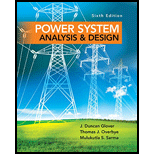
A single-phase,
Trending nowThis is a popular solution!

Chapter 2 Solutions
Power System Analysis and Design (MindTap Course List)
- Fundamentals of Energy Systems HW 4 Q4arrow_forwardFundamentals of Energy Systems HW 4 Q6arrow_forwardConstruct a battery pack to deliver 360V and 450-mile range for a vehicle that consumes 200 Wh/mile, from prismatic cells with 25Ah and 3.6 V. Physical dimensions of the cell are 0.5 cm thickness, 20 cm width and 40 cm length. a) Report configuration of the battery pack. 10-points b) Resistance of each cell is 0.05 Ohm, calculate the total internal resistance of the battery pack. 10-points c) Calculate the voltage drop during discharge when the battery is discharged at 100A. 10-points d) Calculate the amount of anode and cathode to build a prismatic cell with 25Ah capacity. Assume the cell chemistry as: Si anode and [Li(Ni1/3Co1/3Mn1/3)O2] cathode. Atomic weight of elements: Li=7, Si = 28, Ni=58, Co=59, Mn=55, O=16, 10-points e) Calculate the theoretical specific energy (Wh/kg) and practical energy density (Wh/liter) of the battery pack. 10-points f) Calculate the thickness on anode and cathode coating assuming each electrode has 30%…arrow_forward
- I need help with this problem and an explanation of the solution for the image described below. (Introduction to Signals and Systems)arrow_forwardDesign a battery pack for an electric bike that consumes in average 10Wh/mile and drive 30 miles per charge. The battery state of charge window is 80%. Design the battery by using new commercial cylindrical cells with 20mm diameter and 80mm height. The battery is constructed based on graphite anode C6 and cathode Li(Ni0.8Co0.15Al0,05)O2 that provides 3.75V at the cell level and 10Ah capacity. Density of anode is 2.2 g/cm3 and density of cathode is 4.5 g/cm3. Report on the battery pack configuration if the required battery pack voltage is 75 volts. If the thickness of anode and cathode is limited to 130 microns (130 x 10-4 cm) calculate the total electrode surface area in each cell. Assume the porosity of electrodes are 30%. Calculate the weight of active materials (anode and cathode) in grams and the total current collector’s and electrolyte membrane areas in (cm2).arrow_forwardDO NOT USE AI NEED HANDWRITTEN SOLUTION Find total impedance of circuit in polar form and power factor.arrow_forward
- Do NOT WANT AI. need diagram fully labeled pleasearrow_forwardCalculate the current magnitude in the coils e1, e2 of theMagnetic circuit, if:ɸa = 3.00 x 10^-3 Wb, φb = 0.80 x 10^-3 Wb, ɸc = 2.20 x 10^-3 Wb L ab = 0.10 m,A ab = 5.0 cm^2L afeb = L acdb = 0.40 mA afeb = A acdb = 20 cm^2 MATERIAL CHARACTERISTICSH (At/m) 240 350 530 1300 5000 9000B (T) 0.7 0.9 1.1 1.3 1.5 1.6arrow_forwardA toroid magnetic circuit is composed of three sections A, B and C, thesection C has an air gap, section A has an 850 round coil thatconsumes a current of 1.2 A. the physical and magnetic properties of each sectionare: Section A: Length = 80 mm, Cross section = 120 mm^2, μr = 400 Section B: Length = 60 mm, Cross section = 40 mm^2, μr = 250 Section C: Length = 50 mm, Cross section = 200 mm^2, μr = 600 Gap: Length = 1 mm, Cross section = 40 mm^2, μr = 1 Calculate:The magnetic field density in each of the sectionsarrow_forward
- 3) Compute the input impedance of Fig. 3. (10 points) Rin R1 R₂ Figure 3 T Vccarrow_forwardShow the workarrow_forward2) A bypass capacitor CE in parallel with RE is added to the above circuit. a) Draw the equivalent small-signal circuit. (10 points) b) Find the input resistance Rib looking into the base. (10 points) c) Find the output resistance looking into the collector, while the source is shorted, i.e. Vs 0 V and Rs = 0 2. (10 points) Vo Vs d) Find the voltage gain A₁ = ✓ using the above equivalent small signal circuit. (10 points)arrow_forward

 Power System Analysis and Design (MindTap Course ...Electrical EngineeringISBN:9781305632134Author:J. Duncan Glover, Thomas Overbye, Mulukutla S. SarmaPublisher:Cengage Learning
Power System Analysis and Design (MindTap Course ...Electrical EngineeringISBN:9781305632134Author:J. Duncan Glover, Thomas Overbye, Mulukutla S. SarmaPublisher:Cengage Learning

